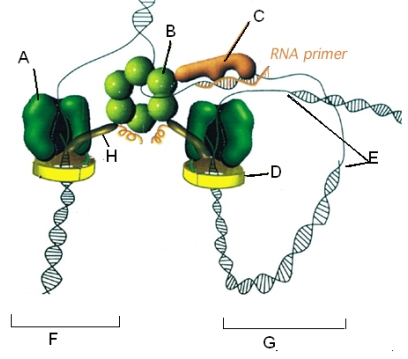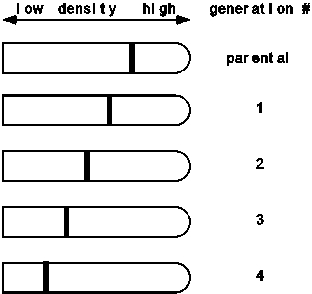A) The DNA pol I works on the leading strand, while DNA pol IIIs work on the Okazaki fragments.since there are several of those, it takes more proteins to keep up.
B) DNA pol I has a built-in proofreading exonuclease; DNA pol III does not.The second DNA pol III is needed to follow the first to accomplish the necessary proofreading.
C) The DNA pol IIIs work at one replication fork, while the DNA pol I works at the other.This way they don't meet exactly at the other side of the chromosome.
D) The DNA pol IIIs do most of the work.DNA pol I only has to work on the telomers.
E) DNA pol I replaces the RNA primers with DNA, which really only needs to be done repetitively on one strand, while both strands are worked on by the DNA pol IIIs.
Correct Answer

verified
Correct Answer
verified
Multiple Choice
When a section of DNA is damaged and polymerization cannot proceed, _____ repair can reconstitute the damaged replication fork.
A) mismatch
B) nucleotide excision
C) recombination
D) photoreactivation
E) base excision
Correct Answer

verified
Correct Answer
verified
Multiple Choice
Which of the following describes the usefulness of primase?
A) It removes RNA bases and replaces them with DNA bases.
B) It seals nicks.
C) It adds an RNA starter sequence which can be elongated.
D) It is only required on the leading strand.
E) It unwinds the DNA.
Correct Answer

verified
Correct Answer
verified
Multiple Choice
Matching Choose the correct answer from the list. Not all the answers will be used. -G-rich polynucleotides can form _______
A) SSB
B) Tus
C) primosome
D) ARS
E) ATS
F) primer
G) transposons
H) nick translation
I) photolyase
J) processive
K) G-loops
L) G-quartets
M) accurate
N) lagging strand synthesis
O) MCM
P) abortive
Correct Answer

verified
Correct Answer
verified
Multiple Choice
Which of the following statements about the fidelity of replication is FALSE?
A) Cells maintaining an equal concentration of each dNTP helps maintain fidelity.
B) DNA polymerase catalyzes synthesis in a two-stage reaction, ensuring the proper base is added.
C) Cells viability is removed when DNA point mutations are incorporated.
D) Pol I and Pol III are both involved in increasing fidelity.
E) Specific repair systems repair and maintain DNA.
Correct Answer

verified
Correct Answer
verified
Multiple Choice
Lagging stands are polymerized in the ______ direction, and the DNA fragments are about ______ nucleotides (nt) long in eukaryotic cells.
A) 5' to 3'0, 100-200
B) 5' to 3', 1000-2000
C) 3' to 5', 100-400
D) 3' to 5', 1000-50000
E) none of the above
Correct Answer

verified
Correct Answer
verified
Multiple Choice
Use the following diagram to complete the sentences below  " ______ is the enzyme which catalyzes phosphodiester bond formation on both strands.Processivity of DNA pol is increased when associated with ____.DNA untwisting is accomplished by ______."
" ______ is the enzyme which catalyzes phosphodiester bond formation on both strands.Processivity of DNA pol is increased when associated with ____.DNA untwisting is accomplished by ______."
A) A, C, B
B) A, B, C
C) B, C, A
D) A, D, B
E) A, E, B
Correct Answer

verified
Correct Answer
verified
Multiple Choice
Use the following information to answer the next questions :
Suppose that an error in replication occurred at position 324 in the E.coli sequence below, and that a GATC motif used to regulate replication and restriction is located about 300 bp away.Note that the A on the bottom (shown by the underlining) strand is methylated.
 -What enzymes would be used to repair this error?
-What enzymes would be used to repair this error?
A) methyl-directed mismatch repair enzymes
B) nucleotide excision repair enzymes
C) methyl-directed double strand break repair enzymes
D) UvrABC plus UvrD
E) None of the above systems can repair this error
Correct Answer

verified
Correct Answer
verified
Multiple Choice
Suppose Meselson & Stahl had observed the following data in their famous experiment involving a switch from medium containing 15N to 14N.What would they have concluded about the nature of DNA replication? 
A) They still would have concluded that DNA replication is semiconservative.
B) They would have concluded that DNA replication is conservative.
C) They would have concluded that DNA replication is dispersive/random.
D) None of the above is correct.
E) Cannot be determined with the information given.
Correct Answer

verified
Correct Answer
verified
Multiple Choice
Use the following information to answer the next questions :
Suppose that an error in replication occurred at position 324 in the E.coli sequence below, and that a GATC motif used to regulate replication and restriction is located about 300 bp away.Note that the A on the bottom (shown by the underlining) strand is methylated.
 -E.coli DNA repair enzymes act on the sequence.Which of the following will result?
-E.coli DNA repair enzymes act on the sequence.Which of the following will result?
A) The underlined A will be changed to a C.
B) The underlined G will be changed to a T.
C) The underlined A will be methylated.
D) The underlined G will be methylated.
E) More than one of the above is correct
Correct Answer

verified
Correct Answer
verified
Showing 41 - 50 of 50
Related Exams